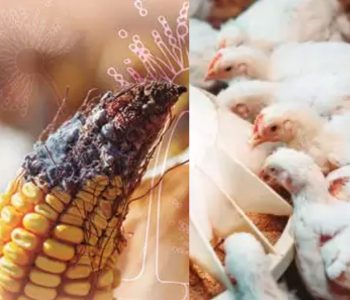DON contamination in feed represents great impact on performance and economic viability in animal production systems. Leading to adverse effects on animals and great economic losses, especially for the monogastric industry. The contamination of feed ingredients with mycotoxins continues to be a great problem in animal diets. Research carried out recently focused on deoxynivalenol (DON) which is a common contaminant in poultry feed. It usually contaminates corn, wheat, barley and other important feed ingredients that suffer from Fusarium fungus infection. Advances in mycotoxin analysis have shed light on the severity of mycotoxin contamination, revealing a worse scenario than was anticipated. As a result production costs associated with mycotoxin contamination and its control continue to increase.
Contaminated grains are usually destined for use in livestock feed despite the fact the best strategy for livestock producers should be to avoid mycotoxin contaminated grain for animal feeding. However, due to the current high incidence and levels of contamination this is not an option. As a result, different strategies have been proposed for minimizing or eliminating the negative effects of mycotoxin contamination in animal feed.
A majority of these strategies, base themselves on the deactivation of mycotoxins through binding agents like silicate clays and activated carbon.These adsorbents can be included in feed in the form of non-nutrient additives. However despite these efforts, current feed additives are not very effective when it comes to mitigating mycotoxins’ negative effects, or they simply don’t have the capacity to neutralize al lot the existing types of mycotoxins.
There are limits to the amount of DON allowed in feed due to the fact that even small amounts of this mycotoxin have negative effects on animal performance. The recommended maximum level for DON in poultry feedstuffs has been set at 5 mg/kg [European Commission Commission Recommendation of 17 August 2006]. Nonetheless, lower doses have been associated with negative impacts on performance(Chen, S.S.et. al; 2017).
On the other hand some reports state that DON contaminants that were above the recommended levels, did not affect animal performance. It was seen that the the inclusion of naturally or artificially contaminated diets with DON at 10 mg/kg DON did not affect performance parameters(body weight gain, feed intake, and feed conversion ratio) in 35 and 42 d old broiler chickens (Ghareeb, K. et. al 2014). An important number of available studies within the literature indicate that the toxic effect associated with DON contamination can be observed when birds are fed with DON concentrations that surpass the 15 mg/kg (Huff, W.E. et al 1986). The latter suggests that poultry may have a relatively higher tolerance to this mycotoxin compared to pigs for example.
Despite this apparent greater resistance, it has been observed that DON-contaminated feed can affect organ weight, blood biochemical, and immunological parameters [Ghareeb, K; et al, 2013). It has also been reported that broilers exposed to dietary DON evidenced a higher stress index (heterophil to lymphocyte ratio) (Xu, L.; Eicher, S.D.; Applegate, T.J. 2015).
Few studies have been carried out to assess the impact and association between DON contamination and animal stress. Fear response is a welfare-related behavior as expressed by tonic immobility reaction and can provide more information on bird’s stress status )Campo, J. L., Gil, M. G., Davila, S. G., & Muñoz, I., 2005). However, lack of information was reported on the effect of DON feeding on this indicator.
Study
A study was carried out to evaluate the effects of different levels of DON contamination(5 and 15 mg/kg feed) on growth performance, relative weight of organs, morphology of the small intestine, serum biochemistry, and welfare parameters of broiler chickens. The present study was carried out on 1-day-old male broilers (Ross 308).
Materials and Methods
Forty-five broiler chicks were randomly divided into three different experimental groups with five replicates each:
- control group received a non-contaminated diet.
- contaminated diet with 5 mg DON/kg of feed.
- contaminated diet with 15 mg DON/kg of feed.
The study had a complete duration of 42 days.
Results and Discussion
- Artificially contaminated feed with DON at the guidance level of(5 mg/kg diet) did not affect broiler growth performance parameters.
- Meanwhile DON contamination at 15 mg/kg of feed reduced body weight gain and altered feed efficiency in the studied birds.
- DON at two assayed levels significantly increased the absolute and relative weight of thymus and the relative weight of gizzard and decreased the absolute and the relative weight of the colon.
- DON at 5 mg/kg reduced creatine kinase levels while i reduce cholesterol levels at 15 mg/kg.
- Greater fear levels were induced in broilers fed DON at 15 mg/kg, compared to those which were fed DON at the guidance level.
Conclusions
- Researchers concluded that in regards to their growth performance, broilers could tolerate DON contamination up until the guidance values, but not at 15 mg/kg.
- The effect of DON is apparent from 5 mg/kg to 15 mg/kg on organ weight. Including: the gizzard, thymus, and colon as well as completely affecting the small intestine’s morphology.
- The impact of both doses was evident on the physiological and behavior status of the evaluated birds. Affecting their blood cholesterol, creatine kinase levels, and fear response.
- The observed modifications of the parameters under evaluation, surged as an indirect response to dietary DON. These observations, allow a better understanding of tolerance levels for DON contamination in poultry feed.
- Researchers within this study suggest that further investigation must be carried out to evaluate and determine biomarkers for DON toxicity. Providing a better set of tools through which health and welfare levels can be assessed and maintained in poultry.
Source: Abstract taken from: “Riahi I, Marquis V, Ramos AJ, Brufau J, Esteve-Garcia E, Pérez-Vendrell AM. Effects of Deoxynivalenol-Contaminated Diets on Productive, Morphological, and Physiological Indicators in Broiler Chickens. Animals. 2020.”
